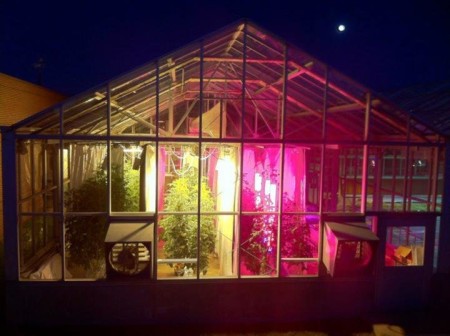Dec
30
Can LEDs Work In Greenhouses?
December 30, 2015 | Leave a Comment
The Purdue team collected physicochemical and sensory data in studies investigating the effect of supplemental light quantity and quality on greenhouse-grown tomatoes. The supplemental intracanopy LED lighting at the intensities and wavelengths used in the study did not negatively affect greenhouse tomato fruit quality or consumer ratings, and thus could be a potential alternative for overhead high-pressure sodium supplementation.

Tomato plants received supplemental lighting from high-pressure sodium lamps or from intracanopy (IC) LED towers. Results showed that tomato quality was largely unaffected by the type of light treatment. Image Credit: Michael Dzakovich. Click image for the largest view.
To satisfy increasing consumer demand for locally grown, fresh tomatoes during off-seasons, greenhouse tomato growers often need to rely on supplemental lighting. The tomato growers are looking to light-emitting diodes (LEDs), favored for their energy-saving potential, as an alternative to high-pressure sodium lamps (HPS) in greenhouse operations.
The paper said, “There is great interest in LEDs potential to influence the phytochemical and flavor profile of various high-value crops,” the authors said. “However, little fruit quality-attribute work with LEDs has been done on a long-duration, full grow-out of tomatoes.”
The researchers conducted three separate studies to investigate the effect of supplemental light quantity and quality on greenhouse-grown tomatoes. Plants were grown either with natural solar radiation only (the control), natural solar radiation plus supplemental lighting from high-pressure sodium lamps, or natural solar radiation plus supplemental light from intracanopy (IC) LED towers. The scientists analyzed plant responses by collecting chromacity, Brix, titratable acidity, electrical conductivity, and pH measurements.
“Contrary to our hypothesis, fruit quality was largely unaffected by direct, IC supplemental lighting,” the authors said.
The study also included sensory panels in which tasters ranked tomatoes for color, acidity, and sweetness using an objective scale. The tasters were also asked to rank tomato color, aroma, texture, sweetness, acidity, aftertaste, and overall approval using a five-point hedonic (preference) scale.
“By collecting both physicochemical and sensory data, we were able to determine whether statistically significant physicochemical parameters of tomato fruit also reflected consumer perception of fruit quality,” the authors said. The sensory panels indicated that physicochemical differences were not noticeable to tasters; in fact, the tasters on the testing panels could not discern between tomatoes from different supplemental lighting treatments or those from the unsupplemented controls.
“This study demonstrated that greenhouse tomato fruit quality was unaffected by both the type of supplemental lighting as well as supplemental lighting per se,” the scientists said. “Physicochemical measurements indicated only slight variation among fruits grown under different lighting regimes, and these findings were supported by nonsignificant differences in sensory attributes.”
The authors said the results are promising for tomato growers interested in reducing energy consumption in greenhouses. “Supplemental IC-LED lighting at the intensities and wavelengths used in this study did not negatively affect greenhouse tomato fruit quality and demonstrates a potential alternative for overhead high-pressure sodium supplementation,” they said.
The Purdue team’s recent study with the new information about the feasibility of using LEDs in greenhouse tomato operations is welcome indeed. Saving money in production is welcome for hopefully, lower cots at the supermarket. For the few readers with their own greenhouses this is good news, too.
The team members include Michael Dzakovich, Celina Gómez, and Cary Mitchell from the Department of Horticulture and Landscape Architecture at Purdue University.
For those looking for more information on what the specific LED application used for the experiments is, please check out the study paper. The savings will likely be quite worthwhile.

